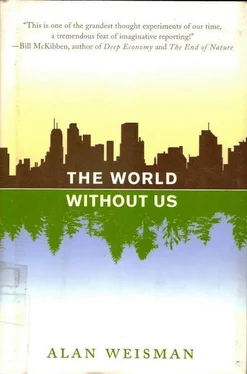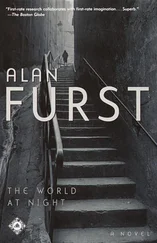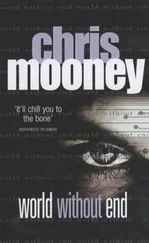Most of all, though, you are beset by what in other contexts is the veritable stuff of life: water. It always wants in.
After we’re gone, nature’s revenge for our smug, mechanized superiority arrives waterborne. It starts with wood-frame construction, the most widely used residential building technique in the developed world. It begins on the roof, probably asphalt or slate shingle, warranted to last two or three decades—but that warranty doesn’t count around the chimney, where the first leak occurs. As the flashing separates under rain’s relentless insistence, water sneaks beneath the shingles. It flows across four-by-eight-foot sheets of sheathing made either of plywood or, if newer, of woodchip board composed of three- to four-inch flakes of timber, bonded together by a resin.
Newer isn’t necessarily better. Wernher Von Braun, the German scientist who developed the U.S. space program, used to tell a story about Colonel John Glenn, the first American to orbit the Earth. “Seconds before lift-off, with Glenn strapped into that rocket we built for him and man’s best efforts all focused on that moment, you know what he said to himself? ‘Oh, my God! I’m sitting on a pile of low bids!’”
In your new house, you’ve been sitting under one. On the one hand, that’s all right: by building things so cheaply and lightly, we use fewer of the world’s resources. On the other hand, the massive trees that yielded the great wooden posts and beams that still support medieval European, Japanese, and early American walls are now too precious and rare, and we’re left to make do with gluing together smaller boards and scraps.
The resin in your cost-conscious choice of a woodchip roof, a waterproof goo of formaldehyde and phenol polymer, was also applied along the board’s exposed edges, but it fails anyway because moisture enters around the nails. Soon they’re rusting, and their grip begins to loosen. That presently leads not only to interior leaks, but to structural mayhem. Besides underlying the roofing, the wooden sheathing secures trusses to each other. The trusses—premanufactured braces held together with metal connection plates—are there to keep the roof from splaying. But when the sheathing goes, structural integrity goes with it.
As gravity increases tension on the trusses, the ¼-inch pins securing their now-rusting connector plates pull free from the wet wood, which now sports a fuzzy coating of greenish mold. Beneath the mold, threadlike filaments called hyphae are secreting enzymes that break cellulose and lignin down into fungi food. The same thing is happening to the floors inside. When the heat went off, pipes burst if you lived where it freezes, and rain is blowing in where windows have cracked from bird collisions and the stress of sagging walls. Even where the glass is still intact, rain and snow mysteriously, inexorably work their way under sills. As the wood continues to rot, trusses start to collapse against each other. Eventually the walls lean to one side, and finally the roof falls in. That barn roof with the 18-by-18-inch hole was likely gone inside of 10 years. Your house’s lasts maybe 50 years; 100, tops.
While all that disaster was unfolding, squirrels, raccoons, and lizards have been inside, chewing nest holes in the drywall, even as woodpeckers rammed their way through from the other direction. If they were initially thwarted by allegedly indestructible siding made of aluminum, vinyl, or the maintenance-free, portland-cement-cellulose-fiber clapboards known as Hardie planks, they merely have to wait a century before most of it is lying on the ground. Its factory-impregnated color is nearly gone, and as water works its inevitable way into saw cuts and holes where the planks took nails, bacteria are picking over its vegetable matter and leaving its minerals behind. Fallen vinyl siding, whose color began to fade early, is now brittle and cracking as its plasticizers degenerate. The aluminum is in better shape, but salts in water pooling on its surface slowly eat little pits that leave a grainy white coating.
For many decades, even after being exposed to the elements, zinc galvanizing has protected your steel heating and cooling ducts. But water and air have been conspiring to convert it to zinc oxide. Once the coating is consumed, the unprotected thin sheet steel disintegrates in a few years. Long before that, the water-soluble gypsum in the sheetrock has washed back into the earth. That leaves the chimney, where all the trouble began. After a century, it’s still standing, but its bricks have begun to drop and break as, little by little, its lime mortar, exposed to temperature swings, crumbles and powders.
If you owned a swimming pool, it’s now a planter box, filled with either the offspring of ornamental saplings that the developer imported, or with banished natural foliage that was still hovering on the subdivision’s fringes, awaiting the chance to retake its territory. If the house’s foundation involved a basement, it too is filling with soil and plant life. Brambles and wild grapevines are snaking around steel gas pipes, which will rust away before another century goes by. White plastic PVC plumbing has yellowed and thinned on the side exposed to the light, where its chloride is weathering to hydrochloric acid, dissolving itself and its polyvinyl partners. Only the bathroom tile, the chemical properties of its fired ceramic not unlike those of fossils, is relatively unchanged, although it now lies in a pile mixed with leaf litter.
After 500 years, what is left depends on where in the world you lived. If the climate was temperate, a forest stands in place of a suburb; minus a few hills, it’s begun to resemble what it was before developers, or the farmers they expropriated, first saw it. Amid the trees, half-concealed by a spreading understory, lie aluminum dishwasher parts and stainless steel cookware, their plastic handles splitting but still solid. Over the coming centuries, although there will be no metallurgists around to measure it, the pace at which aluminum pits and corrodes will finally be revealed: a relatively new material, aluminum was unknown to early humans because its ore must be electrochemically refined to form metal.
The chromium alloys that give stainless steel its resilience, however, will probably continue to do so for millennia, especially if the pots, pans, and carbon-tempered cutlery are buried out of the reach of atmospheric oxygen. One hundred thousand years hence, the intellectual development of whatever creature digs them up might be kicked abruptly to a higher evolutionary plane by the discovery of ready-made tools. Then again, lack of knowledge of how to duplicate them could be a demoralizing frustration—or an awe-arousing mystery that ignites religious consciousness.
If you were a desert dweller, the plastic components of modern life flake and peel away faster, as polymer chains crack under an ultraviolet barrage of daily sunshine. With less moisture, wood lasts longer there, though any metal in contact with salty desert soils will corrode more quickly. Still, from Roman ruins we can guess that thick cast iron will be around well into the future’s archaeological record, so the odd prospect of fire hydrants sprouting amidst cacti may someday be among the few clues that humanity was here. Although adobe and plaster walls will have eroded away, the wrought iron balconies and window grates that once adorned them may still be recognizable, albeit airy as tulle, as corrosion eating through the iron encounters its matrix of indigestible glass slag.
_____
Once, we built structures entirely from the most durable substances we knew: granite block, for instance. The results are still around today to admire, but we don’t often emulate them, because quarrying, cutting, transporting, and fitting stone require a patience we no longer possess. No one since the likes of Antoni Gaudí, who began Barcelona’s yet-unfinished Sagrada Familia basilica in 1880, contemplates investing in construction that our great-great-grandchildren’s grandchildren will complete 250 years hence. Nor, absent the availability of a few thousand slaves, is it cheap, especially compared to another Roman innovation: concrete.
Читать дальше











